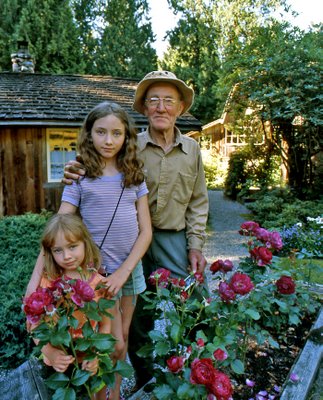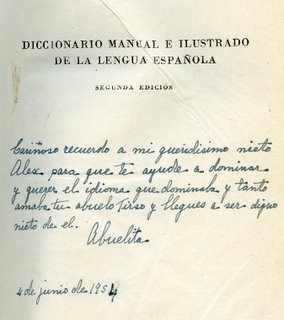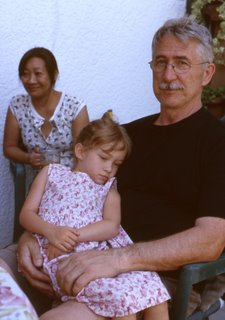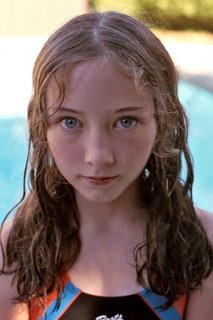Rebecca Wants A Chicken & My Famous Iced Tea
Saturday, July 19, 2008

Rebecca is 10 and will soon be 11. She has become unpredictable. Today in Lillooet her sister Lauren behaved beautifully and was a perfect hostess when Ale's friend, Teresa and her sons John(8) and Thomas(3) came for dinner. Because John was a year younger than Rebecca, she was reluctant to play with him and tried her best to ignore him. With some pressure from Ale and me, she finally played some soccer with him after our dinner. Dinner outside at 28 degrees (with a nice breeze) with the mountains of the Fraser Canyon on either side of our table was heavenly, especially for our stressed out daughter Hilary who is now keen to return to the calm of Lillooet.
In the afternoon Rebecca had visited Ale's neighbour, Mohamed. It seems he has chickens and he allowed Rebecca to pick one up. Rebecca insisted that Ale get some chickens. Ale has her hands full teaching and taking care of her two cats, Ellroy and Banjo. She has no time nor the inclination for chickens. Rebecca said Ale was unfair. " I want a chicken," she told Ale, almost shouting at her. When I explained that Ale did not want a chicken because she was afraid to cross the street, Rebecca burst into what looked like real tears. It all passed.
We were to watch the Masterpiece Theatre version of
Kidnapped but Rebecca said she was uneasy and did not want to see it. In the end she and Ale sat down for Scrabble which gave me the opportunity to write this.
We did not have our pancake breakfast yesterday morning so today Saturday I will not be able to escape from the task. We will leave for Vancouver around noon feeling rested and having enjoyed almost three days away from the city, cellular phones and the reading of the daily newspapers.
The best, of course was the chance to spend the time with all the women of my life, my wife, my two daughters and Rebecca and Lauren. As I made my famous
iced tea Hilary watched. She helped me squeeze the oranges, lemons and the mandarins. She made the comment, " It has been great to find out how you make the tea. When you are gone, we will be able to serve it and be able to say, " This was Papi's famous iced tea."
Lauren, Rebecca, A Dead Snake & Grasshoppers
Friday, July 18, 2008

Lauren at 6 is not the Lauren of before. She is now cuddly and affectionate and doesn't tell me to go away when I ask for a cuddle or a kiss. But there is one aspect about her that seems to be a repetition from her sister Rebecca. Or perhaps it could be imitation. When Lauren poses for me (and she is most eager these days) she looks at the camera in a serious way. My folks no longer ask me why it is I photograph my grandchildren unsmiling.

We are in Lillooet today. The pleasant surprise for all is that we came with Hilary the little girls' mother. It is not especially warm here at 32 but the three of them slept in a tent last night. The breeze must have cooled them a bit. As I write this I am attempting to avoid the making of the thin pancake breakfast. If I get my way it will mean that I will have to make it tomorrow morning.

It is a wonder to watch Rebecca and Lauren look for grasshoppers and other bugs. Yesterday they found a dead (and very dry) garter snake. They put on their bathing suits and ran through Ale's lawn sprinklers. By law Ale has to keep her grass very short and green, if possible, because of the fear of spreading grass fires. Lillooet is a desert and the wind going through the Fraser Canyon can make a fire dangerous.
Rebecca & Lauren Visit John Tuytle
Wednesday, July 16, 2008
ensaimada.
(Del mallorquín ensaïmada, der. de saïm, saín).
1. f. Bollo formado por una tira de pasta hojaldrada dispuesta en espiral.
Real Academia Española © Todos los derechos reservados
Last Friday afternoon Rosemary, our granddaughters and I visited
John Tuytle and his wife at their sheep farm and garden in Langley. We arrived at the farm with its exquisite wood work, from the front gate to the barn and house, all built from scratch by John in 1968 which was the year I married Rosemary in Mexico. John and relatives cleared the land but left very large trees right next to the house and there is even a stream going underneath. The sound of water perhaps reminds John of his remote native land, Holland.
We were shown around by John. We never saw his wife who is convalescing from a terrible bout of cancer. John almost died last year and had extensive heart surgery. But he looked very fit. We tried to approach his sheep and he explained how sheep will always need about 20 ft of grace and a way behind them to escape. The idea of petting a sheep is totally alien. John explained to Rebecca how sheep and deer and others of their ilk have glands between their hooves with which they lay a scent on paths. The sheep go to pasture by one and come back by another.
Rosemary marveled at John's eryingiums and some very rarar plants while Rebecca and I tried to ID many of the roses. After we took some pictures Rebecca asked me me if we could eat the ensaimadas (see above definition!) that I had purchased from Goldilocks as well as the polvorones (Spanish short bread). I told Rebecca that unless John offered us we could not ask. She insisted that perhaps Lauren could ask. I told her it was very rude. We left and in the car Rebecca complained that we had to eat something. This we did (at home). The next day John called to tell us how he and his wife had enjoyed our treats. When I told Rebecca she smiled and understood the value of manners. She also understands and appreciates how generous John has been as many of her roses (the latest being
Rosa glauca)have been given to her by the Dutchman.
Jo-Ann Against The Wall
Monday, July 14, 2008

There is nothing more stifling for photographic creativity than the concept of the studio. This extends to the idea of layers that sometimes end up being separated and with no mingling. Layer one is the backdrop or wall. Layer two is my subject. Layer four is my light (or lights). Layer five is my camera and I am the final layer or layer six. To make it all worse some photographers will offer their model wine and then play loud heavy metal or hip-hop. Then they tell the model, "Do something." This usually results in nothing.
Sometimes I have to get out of that mold. Here I have Jo-Ann against the wall (combining layer one with two) and I used one old Hollywood light. It is refreshing for me to not use the predictably accurate studio flash (Dynalites).

I place my camera on a tripod and use faster film since the exposures will need slower
speeds. These pictures of Jo-Ann remind me of
some of the pictures taken in the 30s. I am no Man
Ray, but Jo-Ann could certainly be my Lee Miller. I have added the blue/cyan colour to imitate that 30s avant-garde.
Sunday, July 13, 2008
In May 1992 I had my first feature story (with photographs) in
Western Living. Rosemary and I had been gardening in our new Athlone St. home since 1986 and by then we sort of thought we knew enough that I could write about it. I will include that article here, verbatum and as I transcribe it I am sure I will gasp of the ignorance of it all! As my grandmother used to say, "La ignorancia es atrevida." (Ignorance is daring.)
The Education of a Gardener
When you don't know the difference between a philodendron and a rhododendron, it is nice to have a ghost around the house that you can turn for advice.
I never met Kay Young. But I have come to know her quite well through her garden. When my wife Rosemary, and I purchased her home in the fall of 1986, we were in love with the house but terrified of the yard. The plants and the flowers had been neglected by the interim owners, while a large rectangular patch of dead grass was evidence that a trampoline had once dominated the back yard. The carp in the fish pond swam blindly in murky water. When it came to gardening, we had no better sense of direction. I didn't know the difference between a rhododendron and a philodendron, or that perennials come back.
Despite this ignorance of all things botanical, I was amazed by the transformation of the garden that first spring. Green sprouts began to pop up out of nowhere. The plants seemed to beckon for my attention. Still, I was afraid as the first time my newborn daughter was placed in my hands and I didn't know how to hold her.
When Kay and her husband, Bill, bought the mock Tudor on this corner lot in Kerrisdale in 1952, the house was as lovely as it is now, but the landscaping was nondescript. Kay immediately set to work. She planted the hawthorn and a laurel hedge in the front yard, and put in cherry trees and an apple tree in the back. She chose her rhododendrons and azaleas so that they would bloom consecutively between January and June. A circular flower bed in the middle of the lawn showed off her hybrid tea roses. She had a fish pond built, but was never able to keep it from leaking.
Next to the gazebo she planted a very fragrant red climbing rose and two flowering Japanese quinces. A neighbour's thujas eventually grew so tall they blocked out the sun on the south side. Undeterred, Kay simply added shade-loving (A 2008 correction. I must interject here that my Atlanta gardener friend, W. George Schmid has told me that there is no such thing and that some plants are shade
tolerant.)ferns, white astilbes, periwinkles, violets and Salomon's seal. Her green thumb knew no bounds. Outside the white picket fence, she planed more roses and delphiniums in the lane.
Although she was alone after her husband died in 1979, she couldn't leave her plants. Then in her eighties and unable to do the upkeep herself, she hired Harry Nomura to be her hands. Harry, who had been taking care of gardens in the neighbourhood for more than 20 years, never seemed to mind her supervision.
I would eventually turn to Harry for help. When one of our evergreens suddenly wilted, the attending tree doctor was more like a funeral director. "It's tree rot. Nothing can be done. Remove it." The rhododendrons developed notches, cause by weevils that I was never able to see, let alone fight. When I asked friends of advice, the instructions were completely baffling. "Lime it. De-thatch it. Spray it."
It was time to bring in a professional. When Harry mowed our lawn with his ancient English reel mower, complete with a front grass catcher, I would spy from the top window to figure out the routine. My feeble attempts at copying him met with a stinging rebuke from my wife, "Harry wouldn't do it that way," she'd say. "You'd better go and ask Harry. "Harry was God, but I wasn't much of a prophet. His most mysterious act was the fall pruning, which seemed to be somewhere between integral calculus and brain surgery. Yet whenever I asked Harry to identify some of the plants, he would answer in his cryptic English, "Japonica this or japonica that." According to the gospel of Harry, we were the guardians of yard full of japonicas.
By our second year in Kay's house, I was beginning to know my way around a plant encyclopedia. Investigating on my own I realized that some of Harry's japonicas were really hydrangeas, magnolias and the brightest of read camellias. Instead of the frightening unknown, the garden had become an endless source of wonder. A weed-like shrub I almost cut down was actually a buddleia , whose fragrant purple blooms attracted butterflies, bees and the odd daring snail. An azalea that I had left for dead in the winter bloomed again in spring. It turned out to be deciduous. One day I discovered an aluminum tag under the climbing rose, identifying it as Don Juan. It had died after a late March frost, but I was quickly able to replace it.
I began to do more and Harry less. Of course a little knowledge is dangerous. Brown patches of dead grass suddenly appeared, the result of too much fertilizer. The bits of grass that I then planted to cover up the bare spots developed into aggressive patches of crab grass. Still, after a full year under Harry's tutelage, I was feeling confident, overconfident, in fact. I no longer looked at liming the lawn in the spring as one of life's great mysteries. Like scarifying or hand de-thatching, it had become routine. Instead of following Harry's lead and trimming the long laurel hedge in the front garden with mechanical trimmers (he never uses the electrical variety, saying they chew up the thick branches without cutting them cleanly), I decided to do Harry one better, pruning it one leaf at a time with rose secateurs.
The last time I hired Harry, it was my turn to utter the rebuke. As part of the fall cleanup, he had gone ahead and pruned the many hydrangeas, cutting off the dry mopheads that protect the emerging buds from the late winter frosts. That didn't mean that I was beyond reproach myself. I was smart enough not to ask Harry why my roses had lost all their leaves by summer. Much later I found out that my indiscriminate late-afternoon waterings had prevented the rosebushes from drying, leaving them susceptible to black spot.
Such wisdom doesn't come easily or cheaply. I now own endless books about shrubs, roses, hostas and perennials, and too many guides to growing the perfect lawn. Most of them look good on the coffee table, but only a few are useful to be dog-eared with use, such as my
Wyman's Gardening Encyclopedia. I also have four years' worth of garden sprinklers; a series of plastic cheapies finally ended with an investment in a solid brass pulsating one.
As I adjust the brass sprinkler to avoid the roses, I can feel Kay Young's presence. Sitting on the soft moss and Corsican mint that grow under the Japanese maple by the pond, I picture her in her plastic rain cap and plastic boots snipping the wilted fern fronds. There are still so many puzzles. I don't understand, for example, why the wisteria near the kitchen never blooms. I have done everything the experts suggest, even ignoring it as some books suggest. I would like to ask Kay if it bloomed for her and what her secret was, but she lives in Toronto now. At the age of 83, she had a stroke in my kitchen, where she lay on the linoleum for two days until a neighbour found her. That was when she had to finally give up the garden, selling the house and moving to Ontario to live with her sister.
Thanks to Rosemary, one of the lessons that I have learned is that it is futile to keep the garden the same, in memory of Kay. Although a dead Don Juan rose can always be replaced, gardens evolve, all by themselves. Rosemary wanted a new perennial bed. She made numerous trips to nurseries and came back with hardy geraniums, white lily of the Nile, exotic Himalayan blue poppies, and white bleeding hearts. I have developed an obsession for a plant Kay never thought of, an exotic leafed shade loving perennial called a hosta. My collection now numbers more than a hundred, fighting Kay's rhododendrons for prominence.
As Kay's presence slowly diminishes, there is another person I am getting to know through her garden. Me. The apple and the cherry trees died, one by one, of blight and old age, yet I no longer grieve for what's gone. Their places have been taken by a young ginkgo, a stewartia with beautiful defoliating bark and robinia 'Frisia.' It's golden leaves shimmer in the breeze, the dark green thuja behind it providing the perfect contrasting frame. Looking out of the windows from my home, I cannot tire of the view.
Six years after being dismayed at the prospect of a garden, I'm now impatient for spring to come. I look forward to the minuteman-missile-shaped cones of my hosta shoots. The first ones to emerge are always
Hosta lancifolia. Some like
Hosta sieboldiana 'Blue Lake,' will grow to the size of a dinner plate. They will attract the spring training slugs and snails before they tackle the summer flowering buddleja. Sometimes Harry comes by, and he compliments me on my work: "Roses good this year." I smile. I may not be Harry, not yet, but I have been well supervised.
The Education Of A Gardener - 2008

On June 4, 1954 my grandmother (abuelita) gave me a Spanish language dictionary. I remember the event very clearly because she put the wrong date with her fountain pen when she dedicated it to me. She got all flustered but managed to correct it. The "
dedicatoria" reads:
A loving memory for my very dear grandson Alex, so that it will help you perfect the use and love of the language that your grandfather Tirso spoke and loved so much and that you may someday become grandson that he would be proud of.
Abuelita, June 4, 1954.
Yesterday when we all went to Paul Leisz's Richmond home (it comes with a swimming pool) we were relaxing in his small backyard before our swim when Rebecca went to one of his two roses and sniffed at it. She said, "This is Abraham Darby, ins't it? "I was immediately able to confirm her accurate guess as I had given Paul the very rose last year. She then borrowed Paul's secateurs and began to deadhead both roses and remove the few leaves with blackspot. it ocurred to me that Rebecca at 10 knows more about gardening than I did in 1986.
This morning I thought about the dictionary that my grandmother gave me in 1954. I no longer use it as I find the on-line
RAE much more convenient. But rarely is memory of that dictionary and my grandmother not in my thoughts. I spied the rose book (
A Pocket Guide to Roses - Species, Care And Garden Design by Sandra Lindner )that I had given Rebecca last month. She had left it yesterday when we bypassed coming back home from Paul's and we took her and Lauren directly home.

I opened the book and it didn't take me long to write:
To my dear granddaughter Rebbecca that she may learn to love roses and other plants as your Papi, Abi and my mother Filomena loved.
June 22, 2008

























